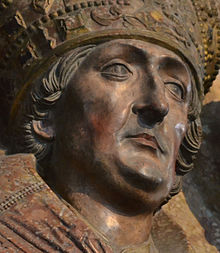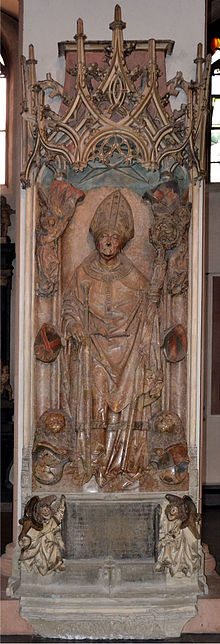Rudolf II of Scherenberg




Rudolf II von Scherenberg (* around 1401 probably in Frankenwinheim ; † April 29, 1495 at the Marienberg Fortress in Würzburg ) was Prince-Bishop of Würzburg from 1466 until his death in 1495.
Family context
Rudolf II came from the Franconian noble family of Scherenberg from the Steigerwald . As the son of Erhard von Scherenberg and Anna von Masbach, he was the last of his line.
Rudolf II as bishop
Rudolf II von Scherenberg was enrolled at the University of Leipzig in 1416/17 and again at the University of Heidelberg in 1437 in order to escape the turmoil in Würzburg that had arisen under Johann II von Brunn . In 1450 he was a scholaster , that is, head of the cathedral school. On April 30, 1466 he was appointed bishop and succeeded Johann III. from Grumbach to. He was confirmed as bishop on June 20 by Pope Paul II and was ordained on September 28.
The bishop was considered a talented administrator. He succeeded in paying off the debts that weighed on the diocese and in redeeming or regaining property and offices. He campaigned for the maintenance of the peace and renewed the alliances of his predecessors. He also succeeded in reconciliation with the Bamberg Monastery . The Scherenberg Gate on the Marienberg Fortress named after him is the entrance to the most important courtyard.
Again and again, Margrave Albrecht Achilles was his opponent, who wanted to make the clergy in his sphere of influence more dependent on himself by introducing the priest tax for his area, along with other measures. Thus the conflict between spiritual and secular power was openly carried out. Together with the Bamberg bishop Philipp von Henneberg , Rudolf II pronounced the church ban and the interdict against Albrecht Achilles. In the Bavarian War , the two bishops took the side of Ludwig the Rich of Bavaria-Landshut in an alliance of convenience against Albrecht Achilles.
With the appearance of Hans Böhm, the drummer from Niklashausen , he got a foretaste of the later peasant war. The seemingly threatening but largely peaceful gatherings of farmers and the new ideas with the call for change were dispelled. Hans Böhm was burned at the stake in Würzburg in 1476 , but the situation escalated about 50 years later during the Peasants' War and turned sharply against the authorities.
In 1480, Rudolf was the first regent to issue instructions for city midwives (more extensive midwifery regulations only became more common in the 16th century). In 1490 and 1494 he issued dress codes for prostitutes.
Epitaph altar by Tilman Riemenschneider in the Würzburg Cathedral
Prince-Bishop Rudolf von Scherenberg is known for his grave in St. Kilian's Cathedral in Würzburg. After he died of a stone disease in 1495, his successor Lorenz von Bibra commissioned Tilman Riemenschneider to design his grave. Lorenz von Bibra had commissioned Riemenschneider during his lifetime to build his own grave just a few meters away from Scherenberg's grave. Today, the two grave monuments stand side by side, from the same limestone , the Adnet marble from Austria, and with a similar motive, but in two different styles, namely late Gothic and Renaissance. One feature that shows how the styles have changed are the facial features of the two prince-bishops: Scherenberg's face shows every wrinkle, while Lorenz's face is idealized. These two graves are among Riemenschneider's most famous works.
In art
- The coat of arms of Rudolps von Scherenberg, Bishop of Würzburg, next to this an unknown coat of arms; about this the figure of a bishop. A sheet in the manner of Mart. Schongauer engraved, for the Missal Herbipolensis from 1479.
literature
- Julien Chapuis : Tilman Riemenschneider: Master Sculptor of the Late Middle Ages. National Gallery London Publications. October 11, 1999, ISBN 0-300-08162-6 .
- Helmut Flachenecker: Rudolf II. Von Scherenberg. In: New German Biography (NDB). Volume 22, Duncker & Humblot, Berlin 2005, ISBN 3-428-11203-2 , p. 192 f. ( Digitized version ).
- Ernst Schubert: Rudolf von Scherenberg. In: Gerhard Pfeiffer (Ed.): Fränkische Lebensbilder. Volume 2, (= Publications of the Society of Frankish history, series VII A. Volume 2). Commission publisher Ferdinand Schöningh, Würzburg 1968, pp. 133–158.
- Alfred Wendehorst: The diocese of Würzburg. Part 3: The row of bishops from 1455–1617. 1978, ISBN 3-11-007475-3 , pp. 20-51.
- Scientific Association for the German Order eV and Historical German Order Compaigne to Mergentheim 1760 eV (Hrsg.): 1300 years of Würzburg - signs of history, images and seals of the bishops of Würzburg . Issue 23. Lauda-Königshofen 2004, p. 42.
- Franz Xaver von Wegele : Rudolf II. Von Scherenberg . In: Allgemeine Deutsche Biographie (ADB). Volume 29, Duncker & Humblot, Leipzig 1889, pp. 566-569.
- Erik Soder from Güldenstubbe : SCHERENBERG, Rudolf, from. In: Biographisch-Bibliographisches Kirchenlexikon (BBKL). Volume 9, Bautz, Herzberg 1995, ISBN 3-88309-058-1 , Sp. 154-157.
Web links
Individual evidence
- ↑ see also list of Frankish knight families # M
- ^ Peter Kolb: The hospital and health system. In: Ulrich Wagner (Hrsg.): History of the city of Würzburg. 4 volumes, Volume I-III / 2 (I: From the beginnings to the outbreak of the Peasant War. 2001, ISBN 3-8062-1465-4 ; II: From the Peasant War 1525 to the transition to the Kingdom of Bavaria 1814. 2004, ISBN 3 -8062-1477-8 ; III / 1–2: From the transition to Bavaria to the 21st century. 2007, ISBN 978-3-8062-1478-9 ), Theiss, Stuttgart 2001–2007, Volume 1, 2001, p 386-409 and 647-653, here: p. 408 f.
- ^ Wolfgang Schneider: Folk culture and everyday life. In: Ulrich Wagner (Hrsg.): History of the city of Würzburg. 4 volumes, Volume I-III / 2, Theiss, Stuttgart 2001–2007, Volume 1 (2001): From the beginnings to the outbreak of the Peasants' War. ISBN 3-8062-1465-4 , pp. 491–514 and 661–665, here: p. 512.
- ↑ Robert Naumann: Serapeum. Journal of library studies, manuscript studies and older literature. First year., TO Weigel . Leipzig 1840., printed by CP Melzer in Leipzig., 192 S. Ordo divinorum secundum Chorum Herbipolensum., Google Books, online , p. 98.
- ↑ INDEX OF THE v.DERSCHAUISCHE Kunstkabinett zu NÜRNBERG ..., Second Division. Nuremberg, at the obliged auctioneer Schmidmer., 1825., directory of rare art collections., 1825., Google Books, online , p. 8, (43.)
| predecessor | Office | successor |
|---|---|---|
| Johann III. from Grumbach |
Prince-Bishop of Würzburg 1466–1495 |
Lorenz von Bibra |
| personal data | |
|---|---|
| SURNAME | Rudolf II of Scherenberg |
| BRIEF DESCRIPTION | Prince-Bishop of Würzburg |
| DATE OF BIRTH | around 1401 |
| PLACE OF BIRTH | Frankenwinheim |
| DATE OF DEATH | April 29, 1495 |
| Place of death | Marienberg Fortress in Würzburg |

